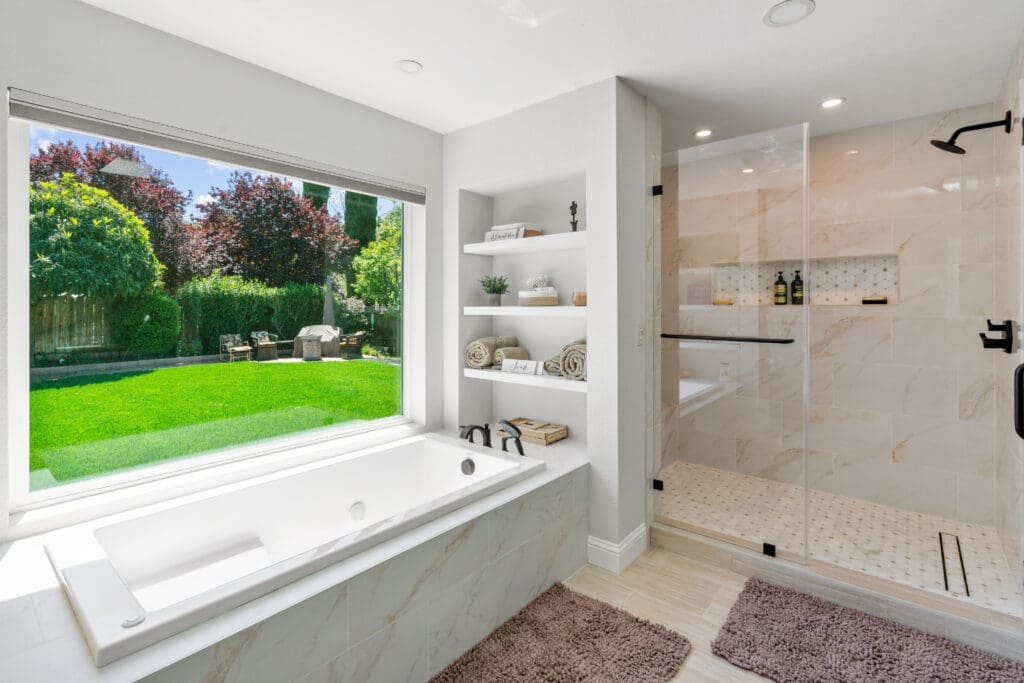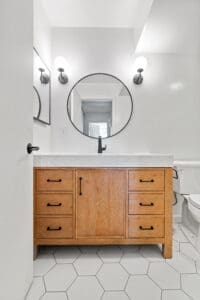What Is The Cheapest Way To Convert My Garage To A Living Space? (Without It Looking Like a Cave!)
Alright, let’s get real. You’ve got that garage. Maybe it’s currently home to dusty exercise equipment, holiday decorations, and that one lawnmower you swear you’ll fix someday. But what if it could be… more? An extra bedroom, a killer home office, a cozy den, or even a rental unit? The dream is real, but the budget? That’s where things get sweaty. We totally get it. As a remodeling company right here in Contra Costa County, we’ve seen the good, the bad, and the “what were they thinking?!” of garage conversions. So, let’s chat about how to transform that concrete box into livable space without taking out a second mortgage.

Why Bother Converting? (Besides the Obvious Cool Factor)
Think about it. Adding square footage inside your existing footprint is usually WAY cheaper than building a whole home addition. No new foundation, often simpler roof lines… it’s like finding hidden treasure under your own roof! Plus, in hot markets like Walnut Creek, Danville, or Oakland, that extra legal living space can seriously boost your home’s value. Cha-ching! Maybe you need a space for aging parents, a home biz HQ, or just a spot to escape the chaos. Converting the garage is often the nearest, smartest solution. But how do we do it cheaply? Buckle up.
The Bare-Bones, Budget-Conscious Blueprint
Forget luxury home renovations for a minute. We’re talking functional, comfortable, and legal – without the gold-plated taps. Here’s the lowdown on keeping that cost down:
- Embrace the “As-Is” Layout (Mostly): The cheapest path involves minimal structural changes. Keep the existing garage door opening? Maybe. But honestly, for a true living space, replacing it with a proper wall and window is usually non-negotiable for comfort, security, and code. The savings come from not moving interior walls within the garage unnecessarily or adding complex bump-outs.
- Insulation is NON-Negotiable (Seriously!): Garages are notoriously drafty, uninsulated caves. Skimping here is false economy. You’ll freeze in winter, roast in summer, and your energy bills will scream. Cost-effective options like fiberglass batts in the walls and ceiling are your best friends. Proper insulation makes the space usable year-round and pays for itself. Thinking about skipping it? Don’t. Just… don’t.
- Flooring: Simple & Durable: That concrete slab? It can be your finished floor! Polish it, stain it, or just give it a good clean and seal. It’s industrial-chic and dirt cheap. If concrete feels too cold (physically and aesthetically), affordable laminate, luxury vinyl plank (LVP), or even sturdy painted plywood can work wonders. Save the fancy hardwood for later.
- Walls & Ceiling: Drywall Dominates: Drywall (sheetrock) is still the king of cost-effective, code-compliant finishes. It’s not glamorous, but it’s fire-resistant and provides a clean surface. Skip the fancy textures or arches. Flat paint hides a multitude of sins. Consider leaving some ceiling beams exposed if they’re in decent shape for a rustic vibe (and savings).
- Electrical: Safe & Smart, Not Extravagant: You need safe, adequate power. This isn’t DIY territory unless you’re a licensed sparky (and even then, permits!). Plan for:
- Enough outlets (code requires them every so many feet).
- Proper lighting – basic ceiling fixtures and maybe a couple of simple sconces.
- Dedicated circuits for major appliances (if you add a minifridge or microwave).
Skip the fancy dimmers, elaborate track lighting, or USB outlets everywhere for now. Focus on safe fundamentals.
- HVAC: Extend, Don’t Build New (If Possible): The biggest budget buster can be heating and cooling. The cheapest route? Extending your existing home HVAC system into the garage, if your current system has the capacity. A small mini-split (ductless) system is often the next best price point for a single, well-insulated room. Avoid expensive new ductwork runs if you can. Space heaters and window AC units are cheap upfront but inefficient and potentially unsafe long-term.
- Plumbing: The Ultimate Budget Wildcard: Adding a full bathroom? Prepare for the price to jump significantly. The cheapest garage conversion avoids plumbing altogether. Need a sink? A simple “wet bar” style setup with cold water only is vastly cheaper than a full bath. If you must have a toilet or shower, position it near existing house plumbing to minimize trenching and pipe runs. Hiring a specialized bathroom renovation contractor for just that part might be smarter than a full general contractor handling everything.
Where You CANNOT Cut Corners (Unless You Like Trouble)
- Permits & Codes: Yeah, it’s boring. Yeah, it costs money. But skipping permits is playing with fire (sometimes literally). Unpermitted work can get you fined, forced to tear it out, void your insurance, and make selling your home a nightmare. Contra Costa County, Walnut Creek, Danville – they all have rules about ceiling height, egress windows (super important for bedrooms!), insulation R-values, electrical, and fire separation. Get the permits. Work with a pro who knows the local rules inside out (like, ahem, folks who do this every day in the Bay Area… hint hint).
- Structural Integrity: Messing with load-bearing walls or the roof? Just don’t. Hire a pro. Period.
- Moisture & Ventilation: Garages are prone to dampness. Ensure proper vapor barriers under flooring if needed, good insulation, and adequate ventilation (like a simple exhaust fan) to prevent mold. This saves money later.
- Fire Separation: Code usually requires a fire-rated wall and door between the garage conversion and the main house, especially if the garage is attached. This is life safety. Don’t ignore it.
The “When to Call EA Home Builders” Moment (Shameless Plug, But Useful!)
Look, we love a good DIY spirit. Painting? Maybe some simple trim? Go for it! But when it comes to structural changes, complex electrical, plumbing, HVAC extensions, or just navigating the permit maze in Contra Costa County, that’s where a home renovation contractor like us at EA Home Builders earns our keep.
- Why call us? We’ve handled countless garage conversions right here in Walnut Creek, Danville, and surrounding areas. We know the inspectors, the common pitfalls, and how to maximize your budget without sacrificing safety or quality. We can handle the whole shebang or just the tricky parts. We’re your nearest expert home improvement partner focused on smart solutions, not just pushing luxury you don’t need.
- Beyond Garages: While garages are a fantastic cost-effective project, we also rock kitchen remodeling, bathroom remodeling, basement remodels, and whole house remodeling. Need a basement remodel contractor or bathroom renovation contractor after the garage is done? We’re your one-stop shop. Check out our reviews!
- Transparency on Cost: We get it. Price is paramount. We offer clear consultations and estimates. No hidden fees. We’ll tell you straight what’s essential, what’s a nice-to-have, and where you can realistically save.
Garage Conversion Cost Estimates: Bare Bones to Functional Chic
Here’s a rough breakdown to give you an idea. Remember, costs vary wildly based on size, location (Oakland vs. Danville labor rates differ), materials chosen, and site complexity. This is for a standard 2-car garage (approx. 400-500 sq ft) with minimal plumbing (maybe a sink).
| Feature/Category | Budget (Bare Bones) | Mid-Range (Functional) | Notes |
|---|---|---|---|
| Design & Permits | $1,500 – $3,000 | $3,000 – $5,000+ | Essential. Includes plans, engineering (if needed), fees. |
| Insulation (Walls/Ceiling) | $1,000 – $2,500 | $2,500 – $4,000 | Fiberglass batts standard. Spray foam costs more. DON’T SKIMP. |
| Garage Door Replacement | $2,000 – $4,000 | $2,000 – $4,000 | Framing wall, insulation, exterior siding, window. Major cost driver. |
| Electrical | $1,500 – $3,000 | $3,000 – $5,000 | Basic lighting, outlets, panel tie-in. Adds up fast with complexity. |
| Flooring | $500 – $1,500 | $2,000 – $4,000 | Stained concrete (cheapest) to LVP/laminate. Carpet not ideal. |
| Walls & Ceiling (Drywall) | $2,000 – $4,000 | $3,000 – $6,000 | Hanging, taping, mudding, priming. Painting extra. Simple is cheaper. |
| HVAC | $1,000 – $3,000 | $3,000 – $8,000+ | Extend existing (cheapest if possible) vs. Mini-split. New ducts=$$$. |
| Plumbing (Sink ONLY) | $1,000 – $3,000 | $1,000 – $3,000 | Adds significant cost. Full bath = $10k-$25k+ easily. |
| Doors/Windows (Interior) | $500 – $1,500 | $1,500 – $3,000 | Basic interior door, maybe one new window if needed for egress/bedroom. |
| Painting & Finishing | $500 – $1,500 | $1,500 – $3,000 | DIY saves here. Priming essential. |
| Contingency (10-15%) | $1,000 – $2,000+ | $2,000 – $4,000+ | ALWAYS have a buffer for surprises! |
| Estimated TOTAL RANGE | $12k – $25k | $25k – $45k+ | Highly variable! Get multiple quotes from home remodeling near me pros. |
FAQs: Your Burning Garage Conversion Questions
-
“Do I really NEED a permit for this in Contra Costa County?”
Absolutely, positively YES. Converting a garage into habitable space triggers building, electrical, and possibly plumbing permits. Skipping them risks fines, forced removal, insurance issues, and major headaches when selling. The closest building department (Walnut Creek, Danville, County HQ) can provide specifics. We handle this daily at EA Home Builders – it’s part of the job! -
“Can I still park a car in there after? Or store stuff?”
Nope. Once it’s permitted as living space, it’s legally living space. That means no parking cars, storing gas cans, or using it as a traditional garage. It needs to meet residential building codes (fire separation, egress, etc.). If you need the parking/storage, this might not be your project. Consider a partial conversion or a shed instead. -
“Will this actually add value to my home? Or hurt it?”
Generally, adding legal, permitted living space increases value, especially in our Bay Area market where square footage is gold. However:- Hurts Value: If you eliminate all parking in an area with street parking issues, or if the conversion is poorly done/unpermitted.
- Helps Value: If it adds a desirable function (bedroom, ADU, office) and is done well/permitted. A good home addition contractor or remodeling company (like yours truly) can advise on the best ROI for your specific home and neighborhood.
Wrapping It Up: Your Garage, Your New Favorite Room (On a Budget!)
Converting your garage cheaply is absolutely possible, but it requires smart choices, realistic expectations, and a focus on the essentials: Insulation, Safety (Permits/Codes!), and Functionality. Avoid the temptation of fancy finishes upfront. Get the structure, envelope, and systems right first. You can always upgrade the flooring or add nicer light fixtures later.
It’s about transforming that underutilized concrete box into something genuinely useful without emptying your wallet. And hey, if the thought of permits, structural headers, or running new circuits makes your head spin? That’s what expert home improvement teams like EA Home Builders are for. We’re your nearest local partner for making garage dreams a (budget-conscious) reality in Contra Costa County, Walnut Creek, Danville, and beyond. Whether it’s a simple conversion or part of a bigger whole house remodeling plan, let’s chat about how to make that garage work for you, not against you. Give us a call – let’s unlock that potential!




